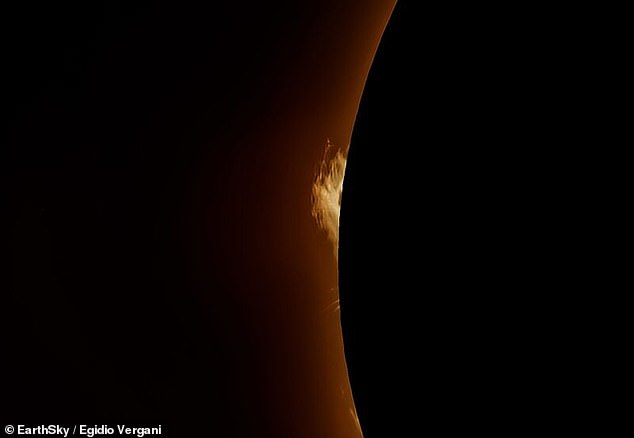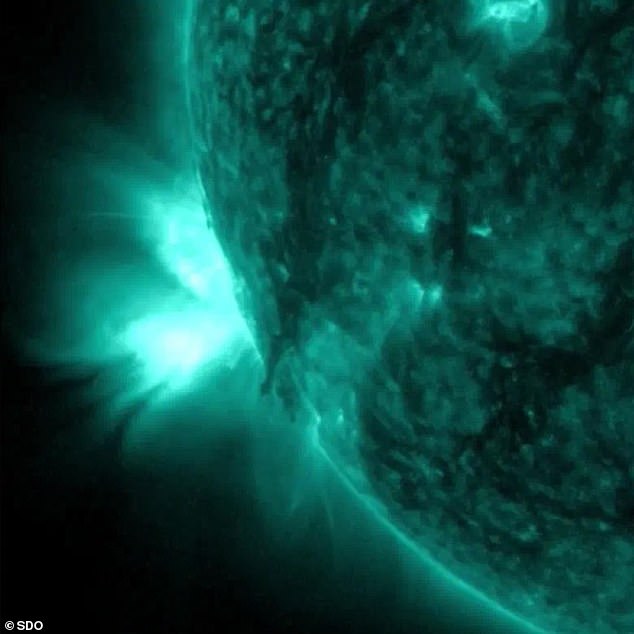Earth is ready for another major solar storm this WEEK, which will produce beautiful auroras – as NOAA gives a 60% chance of radio blackouts
Earth could be hit by another powerful solar storm this week, which is expected to cause radio disruptions and incredible northern lights displays.
Earlier this month, the Sun unleashed the most powerful plasma streams, known as coronal mass ejections (CMEs), in two decades, causing communications disruptions worldwide.
The sunspot that caused the chaos has turned around again, unleashing a powerful solar flare toward Earth’s region on Monday.
The National Oceanic and Atmospheric Administration (NOAA) estimates the chance of radio outages on Tuesday and the rest of the week to be 60 percent.
The sun (pictured) sent out 17 small solar flares and one large X2.9 flare on Monday, the largest class on the rankings
NOAA issued a severe geomagnetic storm warning on May 11, when the same sunspot devastated our planet with dozens of energetic plasma streams.
A solar or geomagnetic storm is a major disturbance of the Earth’s magnetosphere – the region around the Earth that is governed by the planet’s magnetic field.
The NOAA alert was the first since 2005, when Earth was hit by the highest dose of radiation in half a century.
The unusual event earlier this month disrupted GPS, power grids, agricultural equipment and satellites in orbit – and experts are monitoring Monday’s eruption in preparation for the same problems.
The sunspot, labeled AR3664, released 17 solar flares this week, but the strongest one has attracted worldwide attention.
“I have never seen such an explosion in 40 years of observing the Sun,” said amateur astronomer Michael Karrer from Austria. SpaceWeather.
‘So fast, so far into space! It was huge,” he said.
Sunspot AR3664 is not currently pointing directly at Earth, but data suggests it will come into view by the end of the week and could unleash solar storms on our planet.
While the storms are not expected to reach the levels seen earlier this month, they are expected to cause a level three (R3) radio blackout that could last only minutes to hours and could affect GPS systems and radio communications.
GPS systems become disrupted because the radiation emitted by the solar flare hits the magnetic sphere surrounding the Earth, causing fluctuations in the ionosphere.
The ionosphere is a layer in the upper atmosphere that absorbs and reflects signals during geomagnetic storms, creating static electricity and distortions in the signals received by GPS systems.
Auroras are also expected to spread across northeastern Canada this evening, although no official forecasts regarding the solar storm have been released.

The US could be hit by the loss of cell phone communications, GPS signals and hours of power outages due to the solar flares. Shown: Filtered image of the Sun’s solar flare from Milan, Italy

The eruption first emerged from ancient sunspot region AR3664, the same location as the May 10 storm, and marked the first of its kind in 21 years. In the photo: Active region of the Sun that emits solar flares
The sunspot first emitted solar flares on May 10 before spinning away, but if it reappears it could signal a powerful geostorm heading towards Earth.
Earlier this month, a powerful G5 solar storm hit Earth, marking the largest eruption in two decades and expected to collapse U.S. power grids and cause nationwide power outages.
The storm had no significant impact, although some farmers reported losing access to their GPS systems, forcing them to suspend operations.
The National Oceanic and Atmospheric Administration (NOAA) reported that there were no more serious problems because they were prepared.
“Simply put, power grid operators have been busy since yesterday trying to keep good, regulated power flowing without disruption,” Shawn Dahl, a service coordinator for NOAA, told reporters. NPR at the time.
Other astronomers over the past two days have captured images of the sun radiating the solar flare around the world, ranging from Arizona, Virginia and countries as far away as Italy and Chile.
Scientists have warned that these extreme eruptions could be just the start of more powerful solar flares that could hit Earth next year and cause the worst geostorm in 165 years.
In 2019, the Sun had no visible sunspots on its surface, but the US National Space Weather Prediction Center It is estimated that this could be as many as 115 by July 2025.
Astronomers worry that another extreme solar flare could mirror the 1859 Carrington event, which set telegraph wires on fire, disrupted ships’ compasses and cut off communications worldwide.
If an event of that magnitude were to occur today, it would have much broader implications due to modern dependence on technology for daily activities.
This would mean that home medical equipment that requires electricity to function would become useless and without cell phones there would be no way to call 911 in an emergency.
Large geomagnetic storms can also destroy satellites by colliding with other objects in space.
The 2022 geomagnetic storm was the last major storm before early May, destroying up to 40 Starlink satellites worth more than $50 million.
